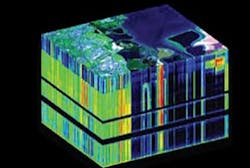Army seeks mature hyper-spectral imaging technology to detect explosives concealed on approaching people
The goal is to develop mast-mounted hyper-spectral imaging sensors for vehicles that can detect explosives and related chemicals approaching at speeds as fast as 12 miles per hour from four to 330 feet away during the day, at night, and in bad weather.
Hyper-spectral sensors differ from multi-spectral sensors in that multi-spectral imagery comes from sensors that measure reflected energy within several specific bands of the electromagnetic spectrum, such as visible green, visible red, and near infrared. Hyper-spectral sensors, on the other hand, measure energy in larger numbers of narrower bands, and are more sensitive to subtle variations in reflected energy.
Army researchers are looking for a turnkey solution that packages its instruments in a stabilized gimbal with two-axis pointing. The system should perform all data processing on a dedicated workstation in the sensor vehicle. The system should include an RF data link to stream detected data to a remote processing and analysis station.
Proposers should consider including remote imaging sensors for situational awareness, how to geo-locate the detection point to within two centimeters, and ways to record imaging and metadata 24 hours a day.
Those interested should respond with white papers no longer than 10 pages The Government will not be responsible for any proprietary information not clearly marked.
E-mail white papers to contract specialist Charlene Buduo at [email protected] no later than 6 May 2011. For questions or concerns, contact budo by e-mail at [email protected] with hyper-spectral RFI - Your Company's Name in the subject line.
Issuing this request for information is the The U.S. Army Contracting Command-APG on behalf of the Army Research, Development, and Engineering Command (RDECOM) Communications-Electronics Research, Development, and Engineering Center (CERDEC) Night Vision and Electronic Sensors Directorate (NVESD) Science and Technology Division (STD) at Fort Belvoir, Va.
More information is online at http://www.fbodaily.com/archive/2011/04-April/08-Apr-2011/FBO-02418750.htm.
